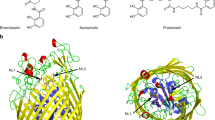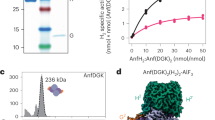Abstract
Deacetoxycephalosporin-C synthase (DAOCS) is a mononuclear ferrous enzyme that transforms penicillins into cephalosporins by inserting a carbon atom into the penicillin nucleus. In the first half-reaction, dioxygen and 2-oxoglutarate produce a reactive iron-oxygen species, succinate and CO2. The oxidizing iron species subsequently reacts with penicillin to give cephalosporin and water. Here we describe high-resolution structures for ferrous DAOCS in complex with penicillins, the cephalosporin product, the cosubstrate and the coproduct. Steady-state kinetic data, quantum-chemical calculations and the new structures indicate a reaction sequence in which a 'booby-trapped' oxidizing species is formed. This species is stabilized by the negative charge of succinate on the iron. The binding sites of succinate and penicillin overlap, and when penicillin replaces succinate, it removes the stabilizing charge, eliciting oxidative attack on itself. Requisite groups of penicillin are within 1 Å of the expected position of a ferryl oxygen in the enzyme–penicillin complex.
This is a preview of subscription content, access via your institution
Access options
Subscribe to this journal
Receive 12 print issues and online access
$189.00 per year
only $15.75 per issue
Buy this article
- Purchase on Springer Link
- Instant access to full article PDF
Prices may be subject to local taxes which are calculated during checkout





Similar content being viewed by others
References
Prescott, A.G. A dilemma of dioxygenases (or where biochemistry and molecular biology fail to meet). J. Exp. Bot. 44, 849–861 (1993).
Valegård, K. et al. Structure of a cephalosporin synthase. Nature 394, 805–809 (1998).
Baldwin, J.E. & Abraham, E. The biosynthesis of penicillins and cephalosporins. Nat. Prod. Rep. 5, 129–145 (1988).
Zhang, Z. et al. Structural origins of the selectivity of the trifunctional oxygenase clavaminic acid synthase. Nat. Struct. Biol. 7, 127–133 (2000).
Wilmouth, R. et al. Structure and mechanism of anthocyanidin synthase from Arabidopsis thaliana. Structure 10, 93–103 (2002).
Elkins, J.M. et al. X-ray crystal structure of Escherichia coli taurine/α-ketoglutarate dioxygenase complexed to ferrous iron and substrates. Biochemistry 41, 5185–5192 (2002).
Clifton, I.J., Hsueh, L.C., Baldwin, J.E., Harlos, K. & Schofield, C.J. Structure of proline 3-hydrolase. Evolution of the family of 2-oxoglutarate dependent oxygenases. Eur. J. Biochem. 268, 6625–6636 (2001).
Dann, C.E.. III, Bruick, R.K. & Deisenhofer, J. Structure of a factor-inhibiting hypoxia-inducible factor 1: an asparaginyl hydroxylase involved in the hypoxic response pathway. Proc. Natl. Acad. Sci. USA 99, 15351–15356 (2002).
Elkins et al. Structure of factor-inhibiting hypoxia-inducible factor (HIF) reveals mechanism of oxidative modification of HIF-1α. J. Biol. Chem. 278, 1802–1806 (2003).
Lee, C., Kim, S.J., Jeong, D.G., Lee, S.M. & Ryu, S.E. Structure of human FIH-1 reveals a unique active site pocket and interaction sites for HIF-1 and von Hippel-Lindau. J. Biol. Chem. 278, 7558–7563.
Roach, P.L. et al. Crystal structure of isopenicillin N synthase, first of a new structural family of enzymes. Nature 375, 700–704 (1995).
Hegg, E.L. & Que, L. Jr. The 2-His-carboxylate facial triad. An emerging structural motif in mononuclear non-heme iron(II) enzymes. Eur. J. Biochem. 250, 625–629 (1997).
Barlow, J.N., Zhang, Z.H., John, P., Baldwin, J.E. & Schofield, C.J. Inactivation of 1-aminocyclopropane-1-carboxylate oxidase involves oxidative modifications. Biochemistry 36, 3563–3569 (1997).
Liu, A., Ho, R.Y.N. & Que, L. Jr. Alternative reactivity of an α-ketoglutarate-dependent iron(II) oxygenase: enzyme self-hydroxylation. J. Am. Chem. Soc. 123, 5126–5127 (2001).
Ryle, M.J. et al. O2- and α-ketoglutarate-dependent tyrosyl radical formation in TauD, an α-keto acid-dependent non-heme iron dioxygenase. Biochemistry 42, 1854–1862 (2003).
Baldwin, J.E. & Schofield, C.J. in The Chemistry of β-Lactams (ed. Page, M.I.) 1–78 (Blackie, London, 1992).
Baldwin, J.E. et al. Substrate specificity of cloned deacetoxycephalosporin C/deacetylcephalosporin C synthetase. J. Antibiot. 41, 1694–1695 (1988).
Dubus, A. et al. Probing the penicillin sidechain selectivity of recombinant deacetoxycephalosporin C synthase. Cell. Mol. Life Sci. 58, 835–843 (2001).
Zhang, Z. et al. Crystal structure of a clavaminate synthase-Fe(II)-2-oxoglutarate-substrate-NO complex: evidence for metal centred rearrangements. FEBS Lett. 517, 7–12 (2002).
Burzlaff, N.I. et al. The reaction cycle of isopenicillin N synthase observed by X-ray diffraction. Nature 401, 721–724 (1999).
O'Brien, J.R., Schuller, D.J., Yang, V.S., Dillard, B.D. & Lanzilotta, W.N. Substrate-induced conformational changes in Escherichia coli taurine/α-ketoglutarate dioxygenase and insight into the oligomeric structure. Biochemistry 42, 5547–5554 (2003).
Solomon, E.I. et al. Geometric and electronic structure/function correlations in non-heme iron enzymes. Chem. Rev. 100, 235–349 (2000).
Zhou, J. et al. Spectroscopic studies of substrate interactions with clavaminate synthase 2, a multifunctional α-KG-dependent non-heme iron enzyme: correlation with mechanisms and reactivities. J. Am. Chem. Soc. 123, 7388–7398 (2001).
Price, J.C., Barr, E.W., Tirupati, B., Bollinger, J.M. Jr. & Krebs, C. The first direct characterization of a high-valent iron intermediate in the reaction of an α-ketoglutarate-dependent dioxygenase: a high-spin Fe(IV) complex in taurine/α-ketoglutarate dioxygenase (TauD) from Escherichia coli. Biochemistry 42, 7497–7508 (2003).
Lee, H.J., Schofield, C.J. & Lloyd, M.D. Active site mutations of recombinant deacetoxycephalosporin C synthase. Biochem. Biophys. Res. Commun. 292, 66–70 (2002).
Lee, H.-J. et al. Kinetic and crystallographic studies on deacetoxycephalosporin C synthase (DAOCS). J. Mol. Biol. 308, 937–948 (2001).
Prescott, A.G. & Lloyd, M.D. The iron(II) and 2-oxoacid-dependent dioxygenases and their role in metabolism. Nat. Prod. Rep. 17, 367–383 (2000).
Pang, C.P. et al. Stereochemistry of the incorporation of valine methyl groups into methylene groups in cephalosporin C. Biochem. J. 222, 777–788 (1984).
Townsend, C.A., Theis, A.B., Neese, A.S., Barrabee, E.B. & Poland, D. Stereochemical fate of chiral/methyl valine in the ring expansion of penicillin N to deacetoxycephalosporin C. J. Am. Chem. Soc. 107, 4760–4767 (1985).
Baldwin, J.E., Adlington, R.M., Kang, T.W., Lee, E. & Schofield, C.J. The ring expansion of penams to cephams: a possible biomimetic process. Tetrahedron 44, 5953–5957 (1988).
Iwata-Reuyl, D., Basak, A. & Townsend, C.A. β-Secondary kinetic isotope effects in the clavaminate synthase-catalysed oxidative cyclization of proclavaminic acid and in related azetidinone model reactions. J. Am. Chem. Soc. 121, 11356–11368 (1999).
Wu, M., Moon, H.-S. & Begley, T.P. Mechanism-based inactivation of the human prolyl-4-hydroxylase by 5-oxaproline-containing peptides: evidence for a prolyl radical intermediate. J. Am. Chem. Soc. 121, 587–588 (1999).
Morin, R.B. et al. Chemistry of cephalosporin antibiotics. III. Chemical correlation of penicillin and cephalosporin antibiotics. J. Am. Chem. Soc. 85, 1896–1897 (1963).
Chin, H.S. & Sim, T.S. C-terminus modification of Streptomyces clavuligerus deacetoxycephalosporin C synthase improves catalysis with an expanded substrate specificity. Biochem. Biophys. Res. Commun. 295, 55–61 (2002).
Szoke, A., Scott, W.G. & Hajdu, J. Catalysis, evolution and life. FEBS Lett. 553, 18–20 (2003).
Retey, J. Enzymatic-reaction selectivity by negative catalysis or how do enzymes deal with highly reactive intermediates. Angew. Chem. Int. Ed. 29, 355–361 (1990).
Lloyd, M.D. et al. Studies on the active site of deacetoxycephalosporin C synthase. J. Mol. Biol. 287, 943–960 (1999).
Terwisscha van Scheltinga, A.C., Valegård, K., Subramanian, R., Hajdu, J. & Andersson, I. Multiple isomorphous replacement on merohedral twins: structure determination of deacetoxycephalosporin C synthase. Acta Crystallogr. D 57, 1776–1785 (2001).
Otwinowski, Z. & Minor, W. Processing of X-ray diffraction data collected in oscillation mode. Methods Enzymol. 276, 307–326 (1997).
Murshudov, G.N., Vagin, A.A. & Dodson, E.J. Refinement of macromolecular structures by the maximum-likelihood method. Acta Crystallogr. D 53, 240–255 (1997).
Jones, T.A., Bergdoll, M. & Kjeldgaard, M. in Crystallographic and Modelling Methods (in Molecular Design) (eds. Bugg, C. & Ealick, S.) 189–190 (Springer, New York, 1990).
Harris, M. & Jones, T.A. Molray—a web interface between O and the Pov-Ray ray tracer. Acta Crystallogr. D 57, 1201–1203 (2001).
Kraulis, P. MOLSCRIPT: a program to produce both detailed and schematic plots of protein structures. J. Appl. Crystallogr. 24, 946–950 (1991).
Esnouf, R.M. An extensively modified version of MolScript that includes greatly enhanced coloring capabilities. J. Mol. Graph. Model. 15, 132–134 (1997).
Merrit, E.A. & Bacon D.J. Raster 3D: photorealistic molecular graphics. Methods Enzymol. 277, 505–524 (1997).
Acknowledgements
We are grateful to C. Schofield and Oxford Centre for Molecular Sciences for discussions and for a supply of DAOC. We thank T. Gunda and L. Eriksson for help. Maxlab, the European Synchrotron Research Facility and the European Molecular Biology Laboratory are acknowledged for beam time and assistance. This work was supported by the European Union Biotechnology Programme and by the Swedish Research Councils.
Author information
Authors and Affiliations
Corresponding author
Ethics declarations
Competing interests
The authors declare no competing financial interests.
Supplementary information
Rights and permissions
About this article
Cite this article
Valegård, K., van Scheltinga, A., Dubus, A. et al. The structural basis of cephalosporin formation in a mononuclear ferrous enzyme. Nat Struct Mol Biol 11, 95–101 (2004). https://doi.org/10.1038/nsmb712
Received:
Accepted:
Published:
Issue Date:
DOI: https://doi.org/10.1038/nsmb712
This article is cited by
-
β-Hydroxylation of α-amino-β-hydroxylbutanoyl-glycyluridine catalyzed by a nonheme hydroxylase ensures the maturation of caprazamycin
Communications Chemistry (2022)
-
Dioxygen activation by nonheme iron enzymes with the 2-His-1-carboxylate facial triad that generate high-valent oxoiron oxidants
JBIC Journal of Biological Inorganic Chemistry (2017)
-
Engineering deacetoxycephalosporin C synthase as a catalyst for the bioconversion of penicillins
Journal of Industrial Microbiology and Biotechnology (2017)
-
ALKBH4-dependent demethylation of actin regulates actomyosin dynamics
Nature Communications (2013)
-
New strategy of site-directed mutagenesis identifies new sites to improve Streptomyces clavuligerus deacetoxycephalosporin C synthase activity toward penicillin G
Applied Microbiology and Biotechnology (2012)



